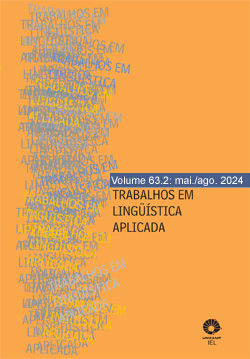Abstract
This Project has as its objective study the moments of intercultural Exchange among Brazilian and American students via Teletandem interaction, as well verify how these moments of development of intercultural competence are perceived by these students in their weekly blog writings. It is grounded in Borghetti and Beaven’s (2015) definition of intercultural learning who consider that interculturality is co constructed during interaction, that is, that the interaction of people from different cultures is potentially a moment of development of intercultural competence. Initial results, based on the reading and analyses of blogs written by American students after each Teletandem interaction, show that they make use of the three different sequences, It points to the fact that, besides the linguistic development, the students are having the opportunity to develop their intercultural competence. The blogs written along the semester show that there has been a significant increase in moments when students have explained aspects if their culture to their partners, as well as moments in which they could already explain their understanding of their partner’s culture. Since the first blog it was possible to notice the attempt to adapt to the contribution of their partners as in the search for topics to discuss (it is necessary to highlight that these interactions happen in an autonomous way without a direct guidance by the professors from each country) and in their opinions about the subjects discussed. The regular contact among the students has made this aspect very easy for all participants.
References
BELZ, Julie A. Linguistic perspectives on the development of intercultural competence in telecollaboration. Language Learning & Technology, v. 7, n. 2, p. 68-99, May 2003.
Byram, M. Teaching and assessing intercultural communicative competence. Clevedon, England: Multilingual Matters, 1997.
BORGHETTI, Claudia; BEAVEN, Ana; R. Pugliese. Interactions among future study abroad students: exploring potential intercultural learning sequences. In: Intercultural Education, 26(1), January 2015.
CAVALARI, S. M. S.; ARANHA, S. Teletandem: integrating e-learning into the foreign language classroom. Acta Scientiarum. Language and Culture, v. 38, n. 4, p. 327-336, Oct.-Dec. 2016. https://doi.org/10.4025/actascilangcult.v38i4.28139.
CANALE, M.; SWAM, M. Theoretical bases of communicative approaches to second language teaching and testing. Applied Linguistics, v. I, Issue 1, p. 1-47, 1 March 1980.
LOPES, Queila Barbosa; FRESCHI, Ana Carolina. Potential intercultural learning sequences in Teletandem: the importance of mediation. Revista do Gel, São Paulo, v. 13, n. 3, p. 49-74, 2016.
MACAIRE, Dominique. Du tandem au tele-tandem: Nouveaux apprentissages, nouveaus outils, nouveaux rôles. Maître de Conference IUFM d’Aquitaine, Bordeaux, 2004. Disponível em: http://www.tele- tandem.de/doclies/macaire- iufm/macaire- iufm1.html. Acesso em: Jan. 2018.
TELLES, J. A.; FERREIRA, M. Teletandem: Possibilidades, dificuldades e abrangência de um projeto de comunicação on-line de PLE. Horizontes em Linguistica Aplicada, v. 9, n. 2, 1-20, 2010.
VAN EK. Objectives for foreign language learning. Volume II: Levels. Council of Europe Publishing, (1986) 1996. 81p.
VASSALLO, Maria Luisa; TELLES, João A. Foreign language learning in- tandem: theoretical principles and research perspectives. The Especialist, v. 27, p. 29-56, 2006.
VASSALLO, Maria Luisa; TELLES, João A. Aprendendo línguas estrangeiras in-tandem: histórias de identidades. Rev. Brasileira de Lingüística Aplicada, v. 8, n. 2, p. 341- 381, 2008.

This work is licensed under a Creative Commons Attribution 4.0 International License.
Copyright (c) 2024 Anelise Dutra, Michael J. Ferreira


